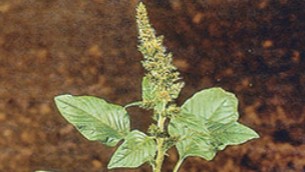Dwarf amaranth
Refer to the link below for more detailed information on specific amaranth species.

Description
Dwarf amaranth seedlings are generally more prostrate than other Amaranthus species, with green leaves and purple leaf margins and veins. Mature dwarf amaranths have rounded leaves but are shorter than other amaranths and taper into a long stalk. Dwarf amaranth flowers are found in dense clusters in the leaf forks and are white or straw-coloured. Although smaller in height than other amaranth species, growing up to 30 cm tall, dwarf amaranths have fruit that are nearly double the size of other amaranth species. The fruit are 3-5 mm long, wrinkled and dark brown to almost black in colour when ripe.
Control
Germinating in spring, dwarf amaranths are best controlled when seedlings are young and actively growing. Dwarf amaranth seeds remain viable in the soil for a relatively short time, giving growers the opportunity to reduce numbers quickly with good weed control.
Roundup Ultra® MAX, Roundup Ready® Herbicide with Plantshield® and Roundup Ready PL are registered for the control of amaranth species in a range of situations.
References
Agrobase Australia (Viewed April 2020), ‘Dwarf amaranth (Boggabri weed)’, https://agrobaseapp.com/australia/weed/dwarf-amaranth
Herbiguide (2014), ‘Dwarf Amaranth’, Herbiguide, http://www.herbiguide.com.au/Descriptions/hg_Dwarf_Amaranth.htm
NSW DPI (Viewed April 2020), ‘Weeds and drought’, https://www.dpi.nsw.gov.au/biosecurity/weeds/weed-and-drought
White, M., Cheal, D., Carr, G.W., Adair, R., Blood, K. and Meagher, D. (2018), ‘Advisory list of environmental weeds in Victoria’, Arthur Rylah Institute for Environmental Research Technical Report Series No. 287, Department of Environment, Land, Water and Planning, Victoria, https://www.ari.vic.gov.au/__data/assets/pdf_file/0027/125919/ARI-Technical-Report-287-Advisory-list-of-environmental-weeds-in-Victoria.pdf








